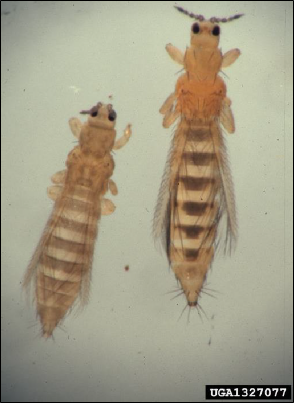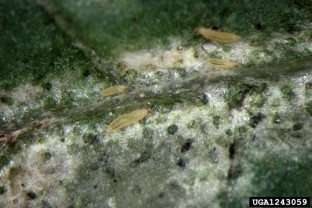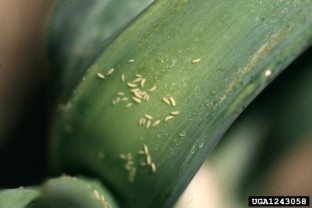Onion Thrips
ID
3104-1556 (ENTO-370NP)
Description
Adult onion thrips are yellowish-brown, slender, elongated insects about 1 mm (0.04 inch) long (Fig. 1). They have two pairs of light-colored, fringed wings and dark eyes. The abdomens have dark brown bands across their width. Larvae are pale with red eyes and lacking wings, but otherwise similar to adults in appearance.

Life Cycle
The thrips life cycle consists of egg, larval, prepupal, pupal, and adult stages. Adult females deposit their eggs in tender leaf tissue. Larval thrips feed on the onion plant. A pre-pupal, non-feeding but actively mobile third stage is found on the soil surface around bases of plants and in the leaf axils. This stage is followed by the pupal stage, during which the insect transforms into the adult stage. The time span from egg to adult can occur in 3-4 weeks. Multiple, overlapping generations occur each year in Virginia. Onion thrips overwinter as adults and immature nymphs in plant debris and weeds.
Populations of thrips do very well in hot, dry weather. They can be carried on the wind into new fields and gardens.
Plants Attacked
Primarily onion, but also beans, beet, carrot, cabbage, cauliflower, celery, cucumber, garlic, melons, peas, squash, tomato, and turnip. They are also found on cereal crops and weedy plants.
Damage
Both adults and larvae rasp leaf tissue and feed on the released juices from plants. Feeding damage on onion appears as white blotches or silver streaks on leaves (Fig. 2), with the tips of leaves withering and browning. Tiny spots of dark fecal droppings may be found on damaged plant tissue. Examine damaged plants for thrips, but thrips are very active and can quickly leave a plant when disturbed. Yellow sticky cards can be helpful in documenting the presence of thrips and monitoring population levels.
Distribution
Throughout the United States.
Cultural Control
Some varieties of sweet onion are resistant to thrips. Clean up plant debris at the end of the season to discourage thrips from overwintering in and near the garden.

Organic/Biological Control
Apply a dust of diatomaceous earth to control thrips. Minute pirate bugs and some lady beetles are predators of thrips.
Chemical Control
Treat with a registered insecticide when thrips appear in damaging numbers. Materials should be applied into the leaf axils where thrips feed (Fig. 3). Consult the most recent edition of the Virginia Pest Management Guide for current information on registered insecticides labeled for thrips. Homeowners should see “thrips” in Home Grounds and Animals (VCE 456-018). Commercial growers should consult the section appropriate for their specific crop in Horticultural and Forest Crops (VCE 456-017) or in the Mid-Atlantic Commercial Vegetable Recommendations (VCE 456-420).
Remarks
Thrips is the correct word whether referring to singular and plural insects in the order Thysanoptera.

Revised
Theresa A. Dellinger, March 26, 2020.
Virginia Cooperative Extension materials are available for public use, reprint, or citation without further permission, provided the use includes credit to the author and to Virginia Cooperative Extension, Virginia Tech, and Virginia State University.
Virginia Cooperative Extension is a partnership of Virginia Tech, Virginia State University, the U.S. Department of Agriculture, and local governments. Its programs and employment are open to all, regardless of age, color, disability, sex (including pregnancy), gender, gender identity, gender expression, genetic information, ethnicity or national origin, political affiliation, race, religion, sexual orientation, or military status, or any other basis protected by law.
Publication Date
May 1, 2020



